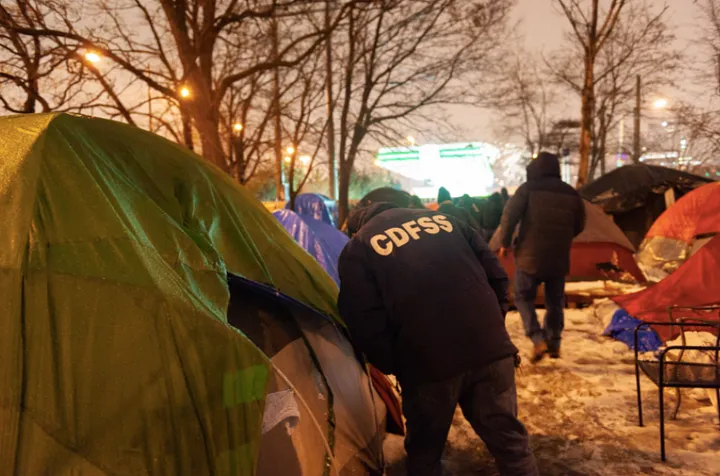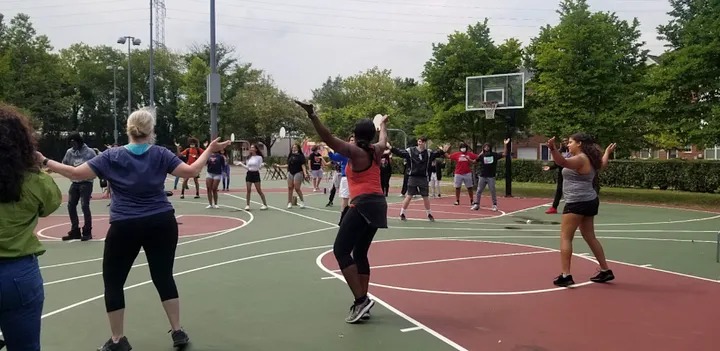Chicago, Illinois, USA
How Chicago Is Improving Homeless Shelters Through Results-Driven Contracting.
Project Type:
Equity, Finance, High-Performing Government, Homelessness
2023 Gold Certification
In 2019, the Chicago Department of Public Health gathered data on the health and life expectancy of Chicago residents, and the social and institutional inequities affecting both. It then used this data to prioritize, plan and implement the goals and strategies of Healthy Chicago 2025, the City’s five-year community health improvement plan. The plan’s vision is for a city where all people and communities have power and equitable access to resources, environments and opportunities to promote optimal health and well-being. This includes making data available so that communities can use it in their own efforts to promote health equity. One way the City is realizing this vision is through a Data Academy. The Academy teaches residents how to access hyper-local data, to use data to prioritize resources, to effectively communicate data findings, and to learn to write research questions – all with the goal to “Empower communities, with data, to tell their story.”
2021 Silver Certification
Utilizing data as both an information-finding, accountability, and performance management tool.
Applied results-driven contracting strategies to improve Chicago’s homeless services system.
Helped a shelter increase the number of assessments it completed from 63% to 84% by collecting housing data metrics and collaborating with shelters to share resources and practices.
Improving Chicago’s Homeless Services System
On any given night, over 5,000 Chicagoans are experiencing homelessness on the streets or in shelters. “We’re in the middle of a crisis,” Chicago Alderman Harry Osterman, chair of the City Council Committee on Housing and Real Estate, said in September.
Part of the City of Chicago’s response to this long-standing challenge, which the pandemic has worsened, is to create more affordable housing. Chicago Mayor Lori Lightfoot and the Department of Housing announced the largest investment in affordable housing in the city’s history in December 2021. That plan involves 24 developments selected through a first-of-its-kind data-driven racial equity impact assessment.
A commitment to data-driven government and equity is apparent in another key way the City addresses homelessness: improving its homeless services system. A top priority of the Department of Family and Support Services (DFSS), which manages a continuum of coordinated services such as homeless shelters, youth programs, domestic violence programs, veterans resources, and workforce services, is to reduce homelessness. In pursuit of this goal, in recent years DFSS has applied results-driven contracting (RDC) strategies, one of the foundational practice areas of What Works Cities (WWC) Certification.

“DFSS sees data as both an information-finding tool and an accountability and performance management tool,” says Kim Howard, project manager for DFSS’ Homeless Services Division. Mindful that the department is the primary funder of homeless shelters in the city (its funding supports about 70% of shelter beds), the division began looking at the shelter system as a key area where it could apply RDC to drive improvements.
“The reality is that our shelters are under-resourced and overextended, so we wanted to focus their efforts on one key goal: increasing the number of people who quickly transition from the shelter system into permanent housing,” Howard says.
“We aim to infuse equity in everything we are doing to better serve our residents. Data is key to this process.”
Driving Strategic Alignment Across Shelters
From the beginning, DFSS saw its RDC effort as a strategic component of a broader data-driven performance improvement framework called a Commitment to Outcomes. “RDC places the positive outcomes we would like to see for Chicagoans at the center of our work,” says Christian Denes, DFSS’s director of strategic planning and impact. “It’s a tool that aligns funding with goals and builds the foundation for continuous improvement with our partners.”
With critical support from Harvard Kennedy School’s Government Performance Lab (GPL), a WWC expert partner, DFSS developed new RDC processes, including new request for proposal (RFP) and contract requirements, that supported its goals. Prior to implementing new requirements, the department provided shelters with a proposed list of metrics the organizations may be expected to report on during their contract period. Through a three-month pilot in 2018, which involved frequent reviews of data to improve outcomes, the City was able to refine these metrics with the shelters to identify those that mattered most to its North Star: getting more people into permanent housing more quickly. (Tracked metrics include the number of clients and households served, average number of days in shelter program, and percentage of households exiting to permanent housing.)
With lessons learned from the pilot in hand, DFSS then rolled out a new “active contract management” (ACM) process to a cohort of 18 shelters serving families as well as five others serving single adults. The department asked shelters to collectively develop a process map that showed all key activities they did with clients, from when they showed up at the door to when they exited. Completion of the coordinated entry assessment emerged as a crucial metric. This assessment, a national best practice required by the U.S. Department of Housing and Urban Development, ensures that clients are on the list to be matched with permanent housing resources. By collecting data on this metric and bringing shelters together to share best practices, DFSS was able to support one shelter in increasing the number of assessments it completed from 63% to 84%. (Offering more flexible intake hours proved crucial.)

The department’s ACM data review also revealed that a small percentage of families in shelters were accessing permanent housing through the coordinated entry assessment, based on prioritization criteria. Conversations with families and case managers underscored two additional reasons families often continued to remain in shelters: lack of sufficient income and lack of affordable housing. So Homeless Services Division staff ramped up efforts to connect these families with job training services, SNAP benefits, and/or DFSS’ Workforce Development Division.
DFSS was also able to bring data to the Department of Housing to articulate the need for affordable housing earmarked for households making 30% of the Area Median Income (AMI). This advocacy helped shape the $1 billion affordable housing investment plan unveiled in late 2021. Nearly 700 of 2,428 newly built units will be family-sized and 394 units will be affordable to households earning 30% of the AMI.
DFSS is still relatively early in its change journey. The RFP process and shelter contracts (which run on two-year cycles) were updated with key performance indicators for the first time in 2018, and the department has continued to improve its RDC processes through subsequent RFP cycles while also integrating the new approach into its other contracted services. “It’s helpful to think of active contract management as a learning cycle,” Howard says. “We have the goal of improving services right away, but we also take learnings from our service providers and apply them to our next request for proposal.”
Lessons learned by the Homeless Services Division have been shared with all divisions in the department, helping to build a culture of data-driven governance and sparking conversations about the strategic value of data. “Our next step as a department is to dig further into the data from an equity standpoint,” Denes says.
“We want to ensure that those who are most in need are getting the right kind of support.”

